CHCLEG001 Assessment 1: Underpinning Knowledge of Legal and Ethics
VerifiedAdded on 2023/01/03
|15
|5245
|33
Homework Assignment
AI Summary
This document presents a completed assessment for the CHCLEG001 unit, focusing on legal and ethical frameworks within early childhood education and care. The assessment includes a marking sheet and detailed answers to 19 written questions. The questions cover the National Legislative Framework underpinning the National Quality Framework (NQF), including the relevant national law, its purpose, and how it is adopted in each state/territory. The assignment also addresses child protection legislation, other relevant pieces of legislation such as Work Health and Safety, and common legal issues. Furthermore, the assessment explores the difference between legal and ethical problems, ethical dilemmas faced by educators, and resources used for the assessment. The student's answers demonstrate an understanding of the legal and ethical responsibilities of educators, aligning with the Australian Qualification Framework (AQF) level 3.
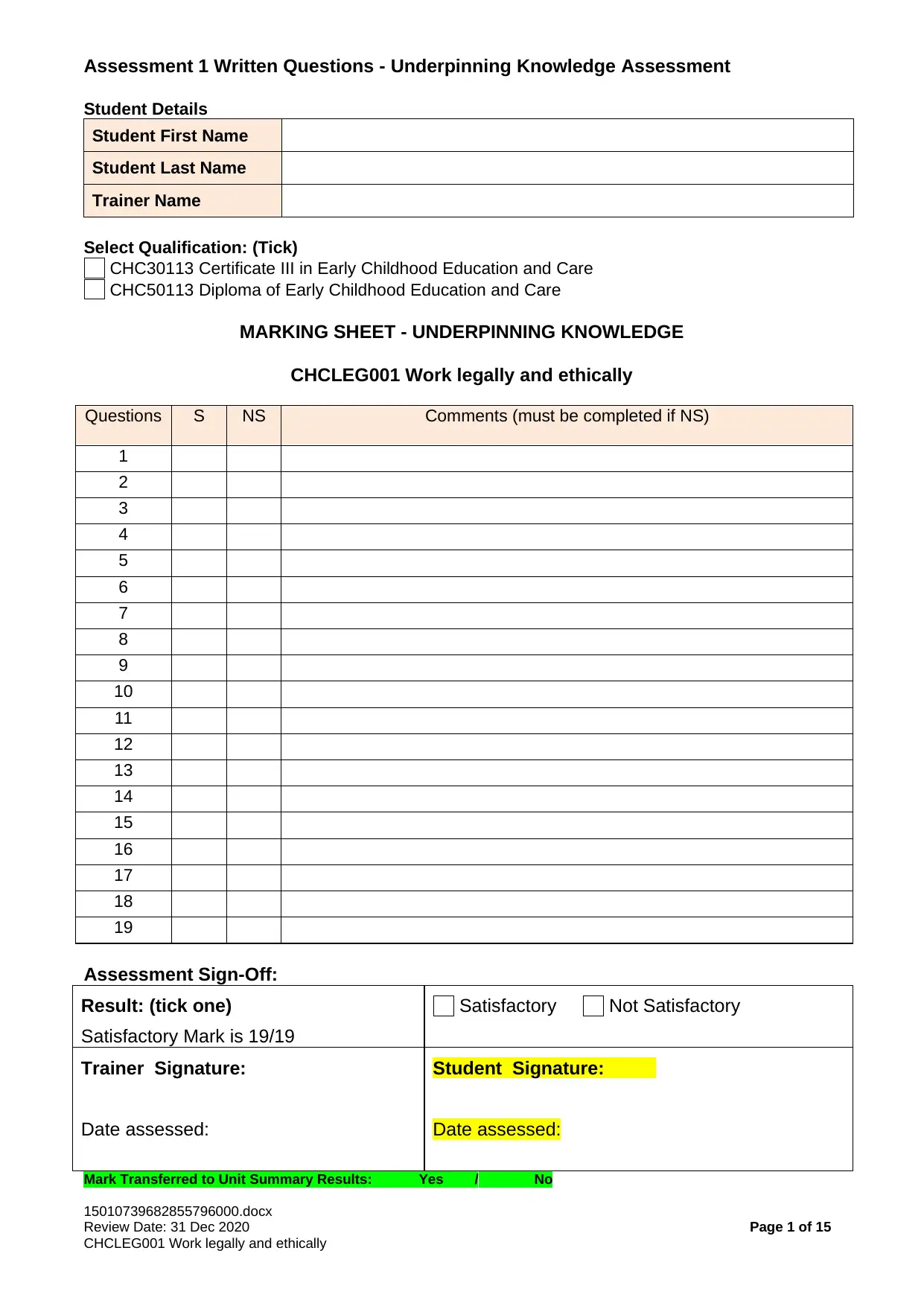
Assessment 1 Written Questions - Underpinning Knowledge Assessment
Student Details
Student First Name
Student Last Name
Trainer Name
Select Qualification: (Tick)
CHC30113 Certificate III in Early Childhood Education and Care
CHC50113 Diploma of Early Childhood Education and Care
MARKING SHEET - UNDERPINNING KNOWLEDGE
CHCLEG001 Work legally and ethically
Questions S NS Comments (must be completed if NS)
1
2
3
4
5
6
7
8
9
10
11
12
13
14
15
16
17
18
19
Assessment Sign-Off:
Result: (tick one)
Satisfactory Mark is 19/19
Satisfactory Not Satisfactory
Trainer Signature:
Date assessed:
Student Signature:
Date assessed:
Mark Transferred to Unit Summary Results: Yes / No
15010739682855796000.docx
Review Date: 31 Dec 2020 Page 1 of 15
CHCLEG001 Work legally and ethically
Student Details
Student First Name
Student Last Name
Trainer Name
Select Qualification: (Tick)
CHC30113 Certificate III in Early Childhood Education and Care
CHC50113 Diploma of Early Childhood Education and Care
MARKING SHEET - UNDERPINNING KNOWLEDGE
CHCLEG001 Work legally and ethically
Questions S NS Comments (must be completed if NS)
1
2
3
4
5
6
7
8
9
10
11
12
13
14
15
16
17
18
19
Assessment Sign-Off:
Result: (tick one)
Satisfactory Mark is 19/19
Satisfactory Not Satisfactory
Trainer Signature:
Date assessed:
Student Signature:
Date assessed:
Mark Transferred to Unit Summary Results: Yes / No
15010739682855796000.docx
Review Date: 31 Dec 2020 Page 1 of 15
CHCLEG001 Work legally and ethically
Paraphrase This Document
Need a fresh take? Get an instant paraphrase of this document with our AI Paraphraser
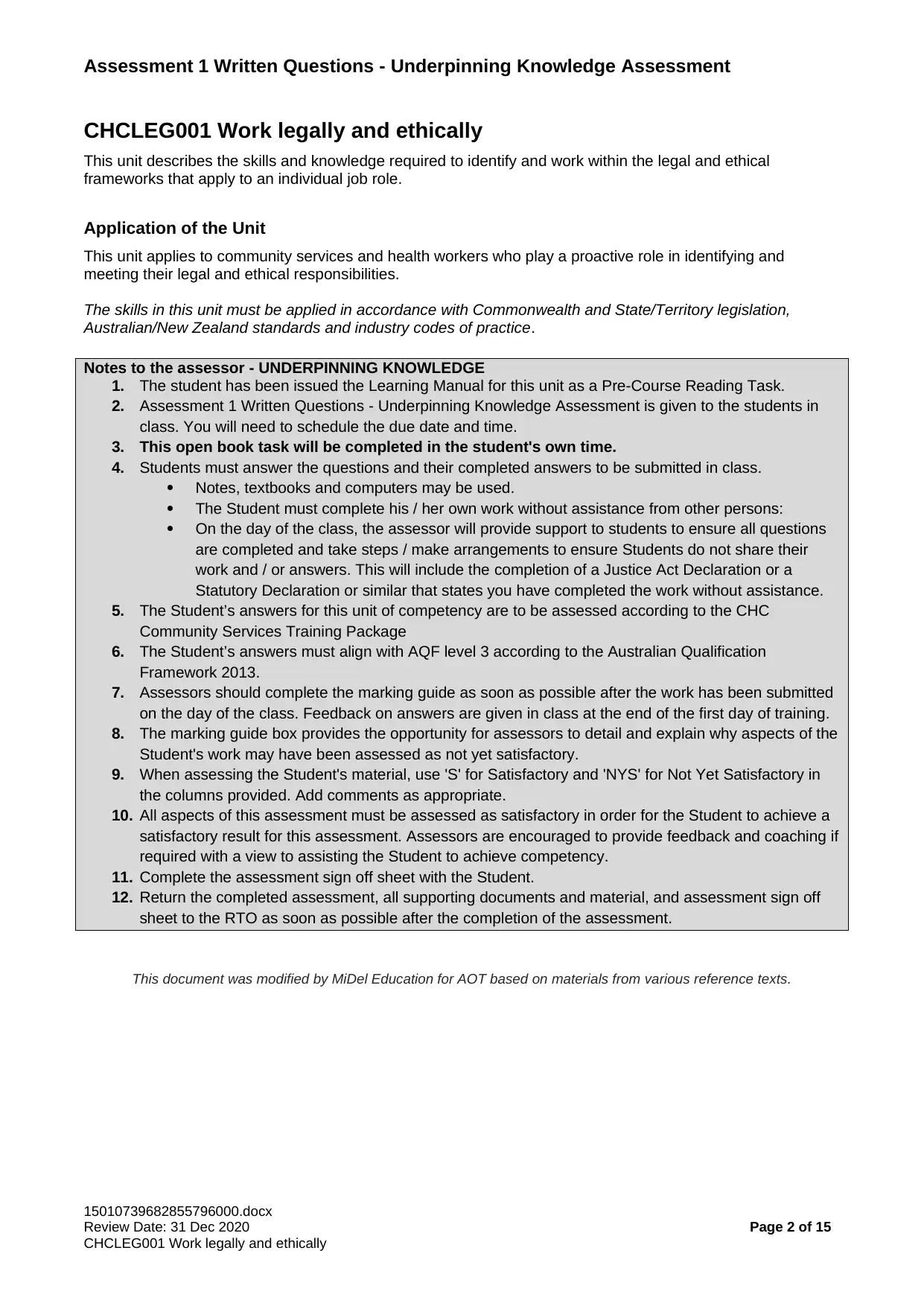
Assessment 1 Written Questions - Underpinning Knowledge Assessment
CHCLEG001 Work legally and ethically
This unit describes the skills and knowledge required to identify and work within the legal and ethical
frameworks that apply to an individual job role.
Application of the Unit
This unit applies to community services and health workers who play a proactive role in identifying and
meeting their legal and ethical responsibilities.
The skills in this unit must be applied in accordance with Commonwealth and State/Territory legislation,
Australian/New Zealand standards and industry codes of practice.
Notes to the assessor - UNDERPINNING KNOWLEDGE
1. The student has been issued the Learning Manual for this unit as a Pre-Course Reading Task.
2. Assessment 1 Written Questions - Underpinning Knowledge Assessment is given to the students in
class. You will need to schedule the due date and time.
3. This open book task will be completed in the student's own time.
4. Students must answer the questions and their completed answers to be submitted in class.
Notes, textbooks and computers may be used.
The Student must complete his / her own work without assistance from other persons:
On the day of the class, the assessor will provide support to students to ensure all questions
are completed and take steps / make arrangements to ensure Students do not share their
work and / or answers. This will include the completion of a Justice Act Declaration or a
Statutory Declaration or similar that states you have completed the work without assistance.
5. The Student’s answers for this unit of competency are to be assessed according to the CHC
Community Services Training Package
6. The Student’s answers must align with AQF level 3 according to the Australian Qualification
Framework 2013.
7. Assessors should complete the marking guide as soon as possible after the work has been submitted
on the day of the class. Feedback on answers are given in class at the end of the first day of training.
8. The marking guide box provides the opportunity for assessors to detail and explain why aspects of the
Student's work may have been assessed as not yet satisfactory.
9. When assessing the Student's material, use 'S' for Satisfactory and 'NYS' for Not Yet Satisfactory in
the columns provided. Add comments as appropriate.
10. All aspects of this assessment must be assessed as satisfactory in order for the Student to achieve a
satisfactory result for this assessment. Assessors are encouraged to provide feedback and coaching if
required with a view to assisting the Student to achieve competency.
11. Complete the assessment sign off sheet with the Student.
12. Return the completed assessment, all supporting documents and material, and assessment sign off
sheet to the RTO as soon as possible after the completion of the assessment.
This document was modified by MiDel Education for AOT based on materials from various reference texts.
15010739682855796000.docx
Review Date: 31 Dec 2020 Page 2 of 15
CHCLEG001 Work legally and ethically
CHCLEG001 Work legally and ethically
This unit describes the skills and knowledge required to identify and work within the legal and ethical
frameworks that apply to an individual job role.
Application of the Unit
This unit applies to community services and health workers who play a proactive role in identifying and
meeting their legal and ethical responsibilities.
The skills in this unit must be applied in accordance with Commonwealth and State/Territory legislation,
Australian/New Zealand standards and industry codes of practice.
Notes to the assessor - UNDERPINNING KNOWLEDGE
1. The student has been issued the Learning Manual for this unit as a Pre-Course Reading Task.
2. Assessment 1 Written Questions - Underpinning Knowledge Assessment is given to the students in
class. You will need to schedule the due date and time.
3. This open book task will be completed in the student's own time.
4. Students must answer the questions and their completed answers to be submitted in class.
Notes, textbooks and computers may be used.
The Student must complete his / her own work without assistance from other persons:
On the day of the class, the assessor will provide support to students to ensure all questions
are completed and take steps / make arrangements to ensure Students do not share their
work and / or answers. This will include the completion of a Justice Act Declaration or a
Statutory Declaration or similar that states you have completed the work without assistance.
5. The Student’s answers for this unit of competency are to be assessed according to the CHC
Community Services Training Package
6. The Student’s answers must align with AQF level 3 according to the Australian Qualification
Framework 2013.
7. Assessors should complete the marking guide as soon as possible after the work has been submitted
on the day of the class. Feedback on answers are given in class at the end of the first day of training.
8. The marking guide box provides the opportunity for assessors to detail and explain why aspects of the
Student's work may have been assessed as not yet satisfactory.
9. When assessing the Student's material, use 'S' for Satisfactory and 'NYS' for Not Yet Satisfactory in
the columns provided. Add comments as appropriate.
10. All aspects of this assessment must be assessed as satisfactory in order for the Student to achieve a
satisfactory result for this assessment. Assessors are encouraged to provide feedback and coaching if
required with a view to assisting the Student to achieve competency.
11. Complete the assessment sign off sheet with the Student.
12. Return the completed assessment, all supporting documents and material, and assessment sign off
sheet to the RTO as soon as possible after the completion of the assessment.
This document was modified by MiDel Education for AOT based on materials from various reference texts.
15010739682855796000.docx
Review Date: 31 Dec 2020 Page 2 of 15
CHCLEG001 Work legally and ethically
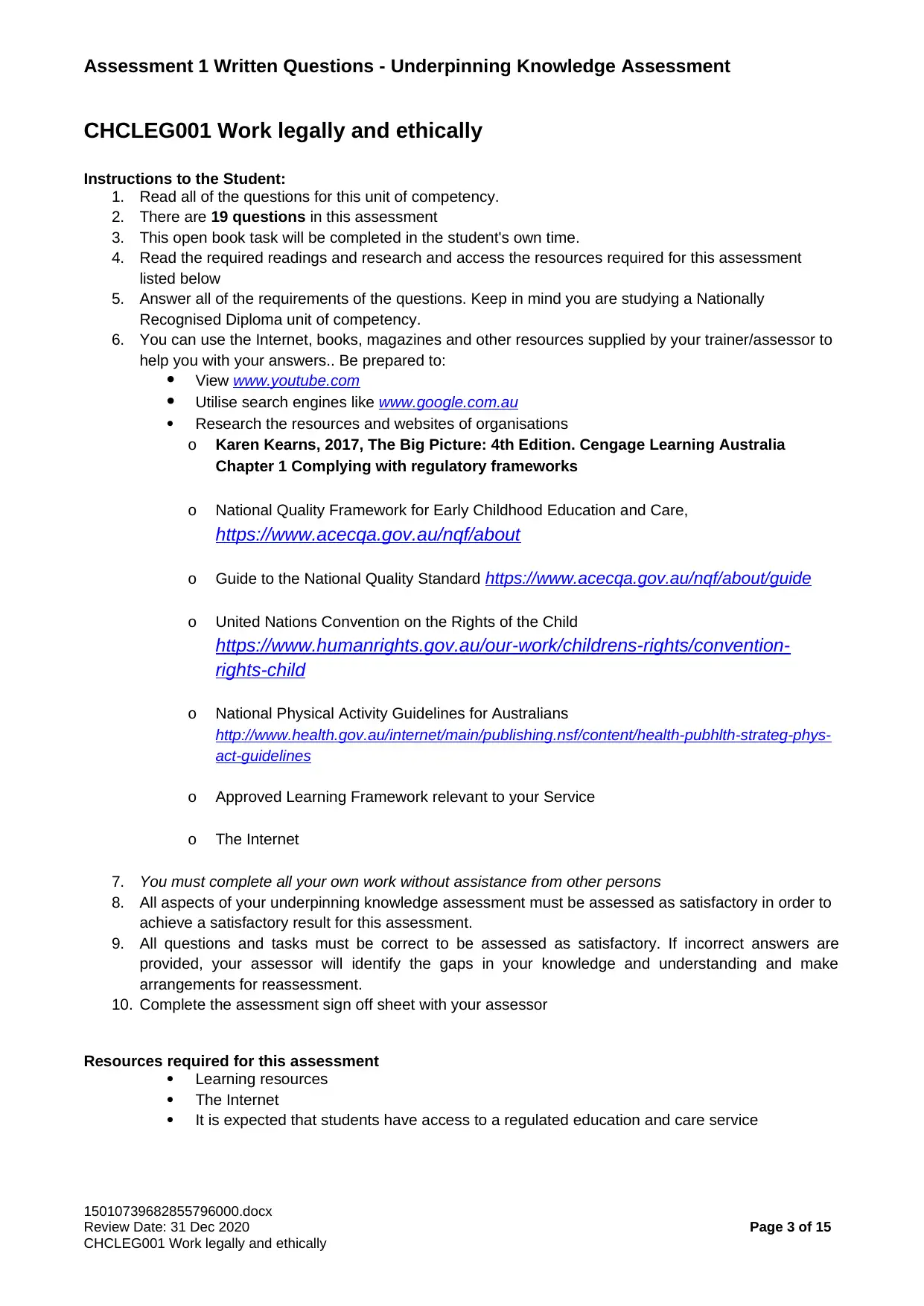
Assessment 1 Written Questions - Underpinning Knowledge Assessment
CHCLEG001 Work legally and ethically
Instructions to the Student:
1. Read all of the questions for this unit of competency.
2. There are 19 questions in this assessment
3. This open book task will be completed in the student's own time.
4. Read the required readings and research and access the resources required for this assessment
listed below
5. Answer all of the requirements of the questions. Keep in mind you are studying a Nationally
Recognised Diploma unit of competency.
6. You can use the Internet, books, magazines and other resources supplied by your trainer/assessor to
help you with your answers.. Be prepared to:
View www.youtube.com
Utilise search engines like www.google.com.au
Research the resources and websites of organisations
o Karen Kearns, 2017, The Big Picture: 4th Edition. Cengage Learning Australia
Chapter 1 Complying with regulatory frameworks
o National Quality Framework for Early Childhood Education and Care,
https://www.acecqa.gov.au/nqf/about
o Guide to the National Quality Standard https://www.acecqa.gov.au/nqf/about/guide
o United Nations Convention on the Rights of the Child
https://www.humanrights.gov.au/our-work/childrens-rights/convention-
rights-child
o National Physical Activity Guidelines for Australians
http://www.health.gov.au/internet/main/publishing.nsf/content/health-pubhlth-strateg-phys-
act-guidelines
o Approved Learning Framework relevant to your Service
o The Internet
7. You must complete all your own work without assistance from other persons
8. All aspects of your underpinning knowledge assessment must be assessed as satisfactory in order to
achieve a satisfactory result for this assessment.
9. All questions and tasks must be correct to be assessed as satisfactory. If incorrect answers are
provided, your assessor will identify the gaps in your knowledge and understanding and make
arrangements for reassessment.
10. Complete the assessment sign off sheet with your assessor
Resources required for this assessment
Learning resources
The Internet
It is expected that students have access to a regulated education and care service
15010739682855796000.docx
Review Date: 31 Dec 2020 Page 3 of 15
CHCLEG001 Work legally and ethically
CHCLEG001 Work legally and ethically
Instructions to the Student:
1. Read all of the questions for this unit of competency.
2. There are 19 questions in this assessment
3. This open book task will be completed in the student's own time.
4. Read the required readings and research and access the resources required for this assessment
listed below
5. Answer all of the requirements of the questions. Keep in mind you are studying a Nationally
Recognised Diploma unit of competency.
6. You can use the Internet, books, magazines and other resources supplied by your trainer/assessor to
help you with your answers.. Be prepared to:
View www.youtube.com
Utilise search engines like www.google.com.au
Research the resources and websites of organisations
o Karen Kearns, 2017, The Big Picture: 4th Edition. Cengage Learning Australia
Chapter 1 Complying with regulatory frameworks
o National Quality Framework for Early Childhood Education and Care,
https://www.acecqa.gov.au/nqf/about
o Guide to the National Quality Standard https://www.acecqa.gov.au/nqf/about/guide
o United Nations Convention on the Rights of the Child
https://www.humanrights.gov.au/our-work/childrens-rights/convention-
rights-child
o National Physical Activity Guidelines for Australians
http://www.health.gov.au/internet/main/publishing.nsf/content/health-pubhlth-strateg-phys-
act-guidelines
o Approved Learning Framework relevant to your Service
o The Internet
7. You must complete all your own work without assistance from other persons
8. All aspects of your underpinning knowledge assessment must be assessed as satisfactory in order to
achieve a satisfactory result for this assessment.
9. All questions and tasks must be correct to be assessed as satisfactory. If incorrect answers are
provided, your assessor will identify the gaps in your knowledge and understanding and make
arrangements for reassessment.
10. Complete the assessment sign off sheet with your assessor
Resources required for this assessment
Learning resources
The Internet
It is expected that students have access to a regulated education and care service
15010739682855796000.docx
Review Date: 31 Dec 2020 Page 3 of 15
CHCLEG001 Work legally and ethically
⊘ This is a preview!⊘
Do you want full access?
Subscribe today to unlock all pages.

Trusted by 1+ million students worldwide
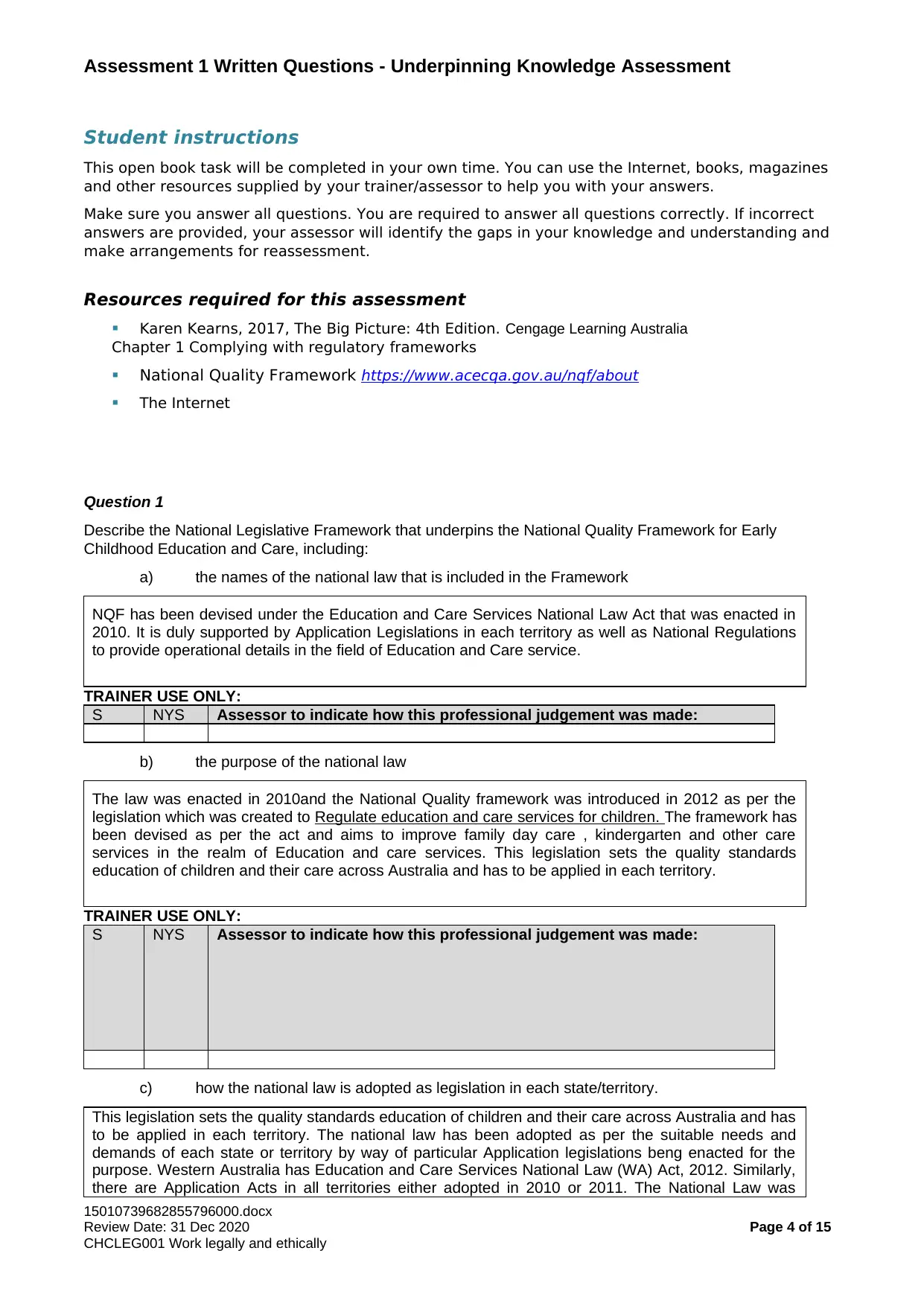
Assessment 1 Written Questions - Underpinning Knowledge Assessment
Student instructions
This open book task will be completed in your own time. You can use the Internet, books, magazines
and other resources supplied by your trainer/assessor to help you with your answers.
Make sure you answer all questions. You are required to answer all questions correctly. If incorrect
answers are provided, your assessor will identify the gaps in your knowledge and understanding and
make arrangements for reassessment.
Resources required for this assessment
Karen Kearns, 2017, The Big Picture: 4th Edition. Cengage Learning Australia
Chapter 1 Complying with regulatory frameworks
National Quality Framework https://www.acecqa.gov.au/nqf/about
The Internet
Question 1
Describe the National Legislative Framework that underpins the National Quality Framework for Early
Childhood Education and Care, including:
a) the names of the national law that is included in the Framework
NQF has been devised under the Education and Care Services National Law Act that was enacted in
2010. It is duly supported by Application Legislations in each territory as well as National Regulations
to provide operational details in the field of Education and Care service.
TRAINER USE ONLY:
S NYS Assessor to indicate how this professional judgement was made:
b) the purpose of the national law
The law was enacted in 2010and the National Quality framework was introduced in 2012 as per the
legislation which was created to Regulate education and care services for children. The framework has
been devised as per the act and aims to improve family day care , kindergarten and other care
services in the realm of Education and care services. This legislation sets the quality standards
education of children and their care across Australia and has to be applied in each territory.
TRAINER USE ONLY:
S NYS Assessor to indicate how this professional judgement was made:
c) how the national law is adopted as legislation in each state/territory.
This legislation sets the quality standards education of children and their care across Australia and has
to be applied in each territory. The national law has been adopted as per the suitable needs and
demands of each state or territory by way of particular Application legislations beng enacted for the
purpose. Western Australia has Education and Care Services National Law (WA) Act, 2012. Similarly,
there are Application Acts in all territories either adopted in 2010 or 2011. The National Law was
15010739682855796000.docx
Review Date: 31 Dec 2020 Page 4 of 15
CHCLEG001 Work legally and ethically
Student instructions
This open book task will be completed in your own time. You can use the Internet, books, magazines
and other resources supplied by your trainer/assessor to help you with your answers.
Make sure you answer all questions. You are required to answer all questions correctly. If incorrect
answers are provided, your assessor will identify the gaps in your knowledge and understanding and
make arrangements for reassessment.
Resources required for this assessment
Karen Kearns, 2017, The Big Picture: 4th Edition. Cengage Learning Australia
Chapter 1 Complying with regulatory frameworks
National Quality Framework https://www.acecqa.gov.au/nqf/about
The Internet
Question 1
Describe the National Legislative Framework that underpins the National Quality Framework for Early
Childhood Education and Care, including:
a) the names of the national law that is included in the Framework
NQF has been devised under the Education and Care Services National Law Act that was enacted in
2010. It is duly supported by Application Legislations in each territory as well as National Regulations
to provide operational details in the field of Education and Care service.
TRAINER USE ONLY:
S NYS Assessor to indicate how this professional judgement was made:
b) the purpose of the national law
The law was enacted in 2010and the National Quality framework was introduced in 2012 as per the
legislation which was created to Regulate education and care services for children. The framework has
been devised as per the act and aims to improve family day care , kindergarten and other care
services in the realm of Education and care services. This legislation sets the quality standards
education of children and their care across Australia and has to be applied in each territory.
TRAINER USE ONLY:
S NYS Assessor to indicate how this professional judgement was made:
c) how the national law is adopted as legislation in each state/territory.
This legislation sets the quality standards education of children and their care across Australia and has
to be applied in each territory. The national law has been adopted as per the suitable needs and
demands of each state or territory by way of particular Application legislations beng enacted for the
purpose. Western Australia has Education and Care Services National Law (WA) Act, 2012. Similarly,
there are Application Acts in all territories either adopted in 2010 or 2011. The National Law was
15010739682855796000.docx
Review Date: 31 Dec 2020 Page 4 of 15
CHCLEG001 Work legally and ethically
Paraphrase This Document
Need a fresh take? Get an instant paraphrase of this document with our AI Paraphraser
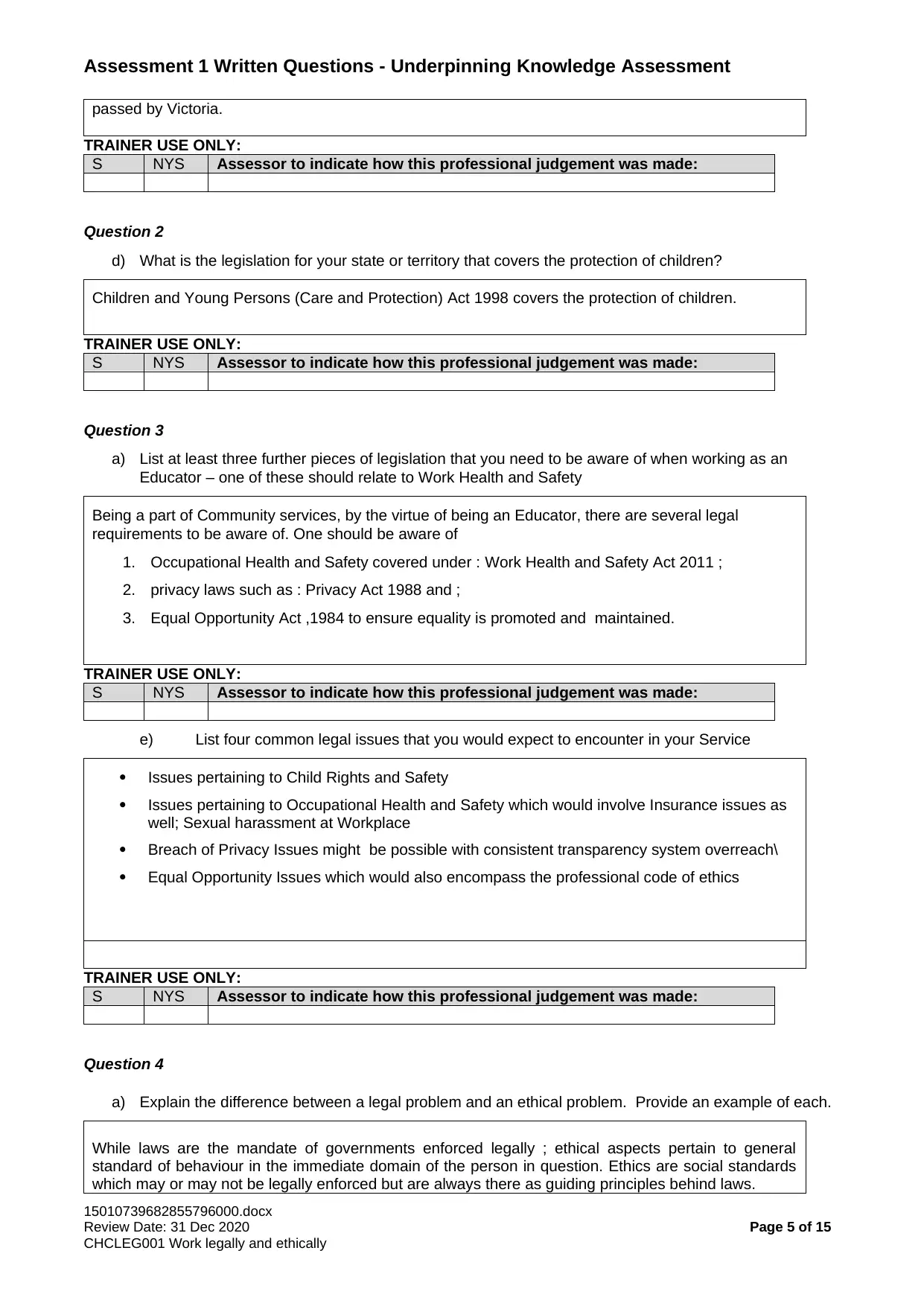
Assessment 1 Written Questions - Underpinning Knowledge Assessment
passed by Victoria.
TRAINER USE ONLY:
S NYS Assessor to indicate how this professional judgement was made:
Question 2
d) What is the legislation for your state or territory that covers the protection of children?
Children and Young Persons (Care and Protection) Act 1998 covers the protection of children.
TRAINER USE ONLY:
S NYS Assessor to indicate how this professional judgement was made:
Question 3
a) List at least three further pieces of legislation that you need to be aware of when working as an
Educator – one of these should relate to Work Health and Safety
Being a part of Community services, by the virtue of being an Educator, there are several legal
requirements to be aware of. One should be aware of
1. Occupational Health and Safety covered under : Work Health and Safety Act 2011 ;
2. privacy laws such as : Privacy Act 1988 and ;
3. Equal Opportunity Act ,1984 to ensure equality is promoted and maintained.
TRAINER USE ONLY:
S NYS Assessor to indicate how this professional judgement was made:
e) List four common legal issues that you would expect to encounter in your Service
Issues pertaining to Child Rights and Safety
Issues pertaining to Occupational Health and Safety which would involve Insurance issues as
well; Sexual harassment at Workplace
Breach of Privacy Issues might be possible with consistent transparency system overreach\
Equal Opportunity Issues which would also encompass the professional code of ethics
TRAINER USE ONLY:
S NYS Assessor to indicate how this professional judgement was made:
Question 4
a) Explain the difference between a legal problem and an ethical problem. Provide an example of each.
While laws are the mandate of governments enforced legally ; ethical aspects pertain to general
standard of behaviour in the immediate domain of the person in question. Ethics are social standards
which may or may not be legally enforced but are always there as guiding principles behind laws.
15010739682855796000.docx
Review Date: 31 Dec 2020 Page 5 of 15
CHCLEG001 Work legally and ethically
passed by Victoria.
TRAINER USE ONLY:
S NYS Assessor to indicate how this professional judgement was made:
Question 2
d) What is the legislation for your state or territory that covers the protection of children?
Children and Young Persons (Care and Protection) Act 1998 covers the protection of children.
TRAINER USE ONLY:
S NYS Assessor to indicate how this professional judgement was made:
Question 3
a) List at least three further pieces of legislation that you need to be aware of when working as an
Educator – one of these should relate to Work Health and Safety
Being a part of Community services, by the virtue of being an Educator, there are several legal
requirements to be aware of. One should be aware of
1. Occupational Health and Safety covered under : Work Health and Safety Act 2011 ;
2. privacy laws such as : Privacy Act 1988 and ;
3. Equal Opportunity Act ,1984 to ensure equality is promoted and maintained.
TRAINER USE ONLY:
S NYS Assessor to indicate how this professional judgement was made:
e) List four common legal issues that you would expect to encounter in your Service
Issues pertaining to Child Rights and Safety
Issues pertaining to Occupational Health and Safety which would involve Insurance issues as
well; Sexual harassment at Workplace
Breach of Privacy Issues might be possible with consistent transparency system overreach\
Equal Opportunity Issues which would also encompass the professional code of ethics
TRAINER USE ONLY:
S NYS Assessor to indicate how this professional judgement was made:
Question 4
a) Explain the difference between a legal problem and an ethical problem. Provide an example of each.
While laws are the mandate of governments enforced legally ; ethical aspects pertain to general
standard of behaviour in the immediate domain of the person in question. Ethics are social standards
which may or may not be legally enforced but are always there as guiding principles behind laws.
15010739682855796000.docx
Review Date: 31 Dec 2020 Page 5 of 15
CHCLEG001 Work legally and ethically
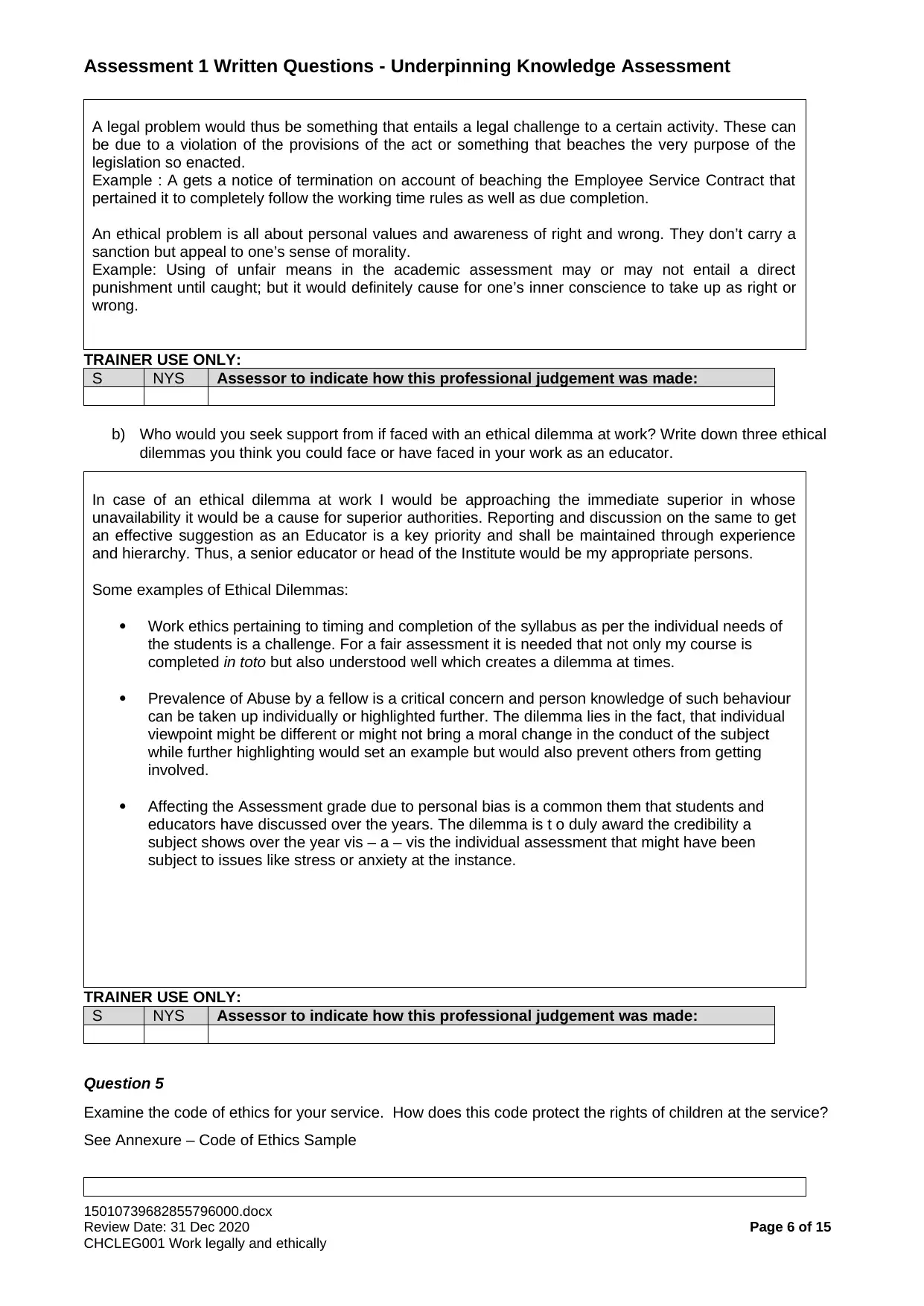
Assessment 1 Written Questions - Underpinning Knowledge Assessment
A legal problem would thus be something that entails a legal challenge to a certain activity. These can
be due to a violation of the provisions of the act or something that beaches the very purpose of the
legislation so enacted.
Example : A gets a notice of termination on account of beaching the Employee Service Contract that
pertained it to completely follow the working time rules as well as due completion.
An ethical problem is all about personal values and awareness of right and wrong. They don’t carry a
sanction but appeal to one’s sense of morality.
Example: Using of unfair means in the academic assessment may or may not entail a direct
punishment until caught; but it would definitely cause for one’s inner conscience to take up as right or
wrong.
TRAINER USE ONLY:
S NYS Assessor to indicate how this professional judgement was made:
b) Who would you seek support from if faced with an ethical dilemma at work? Write down three ethical
dilemmas you think you could face or have faced in your work as an educator.
In case of an ethical dilemma at work I would be approaching the immediate superior in whose
unavailability it would be a cause for superior authorities. Reporting and discussion on the same to get
an effective suggestion as an Educator is a key priority and shall be maintained through experience
and hierarchy. Thus, a senior educator or head of the Institute would be my appropriate persons.
Some examples of Ethical Dilemmas:
Work ethics pertaining to timing and completion of the syllabus as per the individual needs of
the students is a challenge. For a fair assessment it is needed that not only my course is
completed in toto but also understood well which creates a dilemma at times.
Prevalence of Abuse by a fellow is a critical concern and person knowledge of such behaviour
can be taken up individually or highlighted further. The dilemma lies in the fact, that individual
viewpoint might be different or might not bring a moral change in the conduct of the subject
while further highlighting would set an example but would also prevent others from getting
involved.
Affecting the Assessment grade due to personal bias is a common them that students and
educators have discussed over the years. The dilemma is t o duly award the credibility a
subject shows over the year vis – a – vis the individual assessment that might have been
subject to issues like stress or anxiety at the instance.
TRAINER USE ONLY:
S NYS Assessor to indicate how this professional judgement was made:
Question 5
Examine the code of ethics for your service. How does this code protect the rights of children at the service?
See Annexure – Code of Ethics Sample
15010739682855796000.docx
Review Date: 31 Dec 2020 Page 6 of 15
CHCLEG001 Work legally and ethically
A legal problem would thus be something that entails a legal challenge to a certain activity. These can
be due to a violation of the provisions of the act or something that beaches the very purpose of the
legislation so enacted.
Example : A gets a notice of termination on account of beaching the Employee Service Contract that
pertained it to completely follow the working time rules as well as due completion.
An ethical problem is all about personal values and awareness of right and wrong. They don’t carry a
sanction but appeal to one’s sense of morality.
Example: Using of unfair means in the academic assessment may or may not entail a direct
punishment until caught; but it would definitely cause for one’s inner conscience to take up as right or
wrong.
TRAINER USE ONLY:
S NYS Assessor to indicate how this professional judgement was made:
b) Who would you seek support from if faced with an ethical dilemma at work? Write down three ethical
dilemmas you think you could face or have faced in your work as an educator.
In case of an ethical dilemma at work I would be approaching the immediate superior in whose
unavailability it would be a cause for superior authorities. Reporting and discussion on the same to get
an effective suggestion as an Educator is a key priority and shall be maintained through experience
and hierarchy. Thus, a senior educator or head of the Institute would be my appropriate persons.
Some examples of Ethical Dilemmas:
Work ethics pertaining to timing and completion of the syllabus as per the individual needs of
the students is a challenge. For a fair assessment it is needed that not only my course is
completed in toto but also understood well which creates a dilemma at times.
Prevalence of Abuse by a fellow is a critical concern and person knowledge of such behaviour
can be taken up individually or highlighted further. The dilemma lies in the fact, that individual
viewpoint might be different or might not bring a moral change in the conduct of the subject
while further highlighting would set an example but would also prevent others from getting
involved.
Affecting the Assessment grade due to personal bias is a common them that students and
educators have discussed over the years. The dilemma is t o duly award the credibility a
subject shows over the year vis – a – vis the individual assessment that might have been
subject to issues like stress or anxiety at the instance.
TRAINER USE ONLY:
S NYS Assessor to indicate how this professional judgement was made:
Question 5
Examine the code of ethics for your service. How does this code protect the rights of children at the service?
See Annexure – Code of Ethics Sample
15010739682855796000.docx
Review Date: 31 Dec 2020 Page 6 of 15
CHCLEG001 Work legally and ethically
⊘ This is a preview!⊘
Do you want full access?
Subscribe today to unlock all pages.

Trusted by 1+ million students worldwide
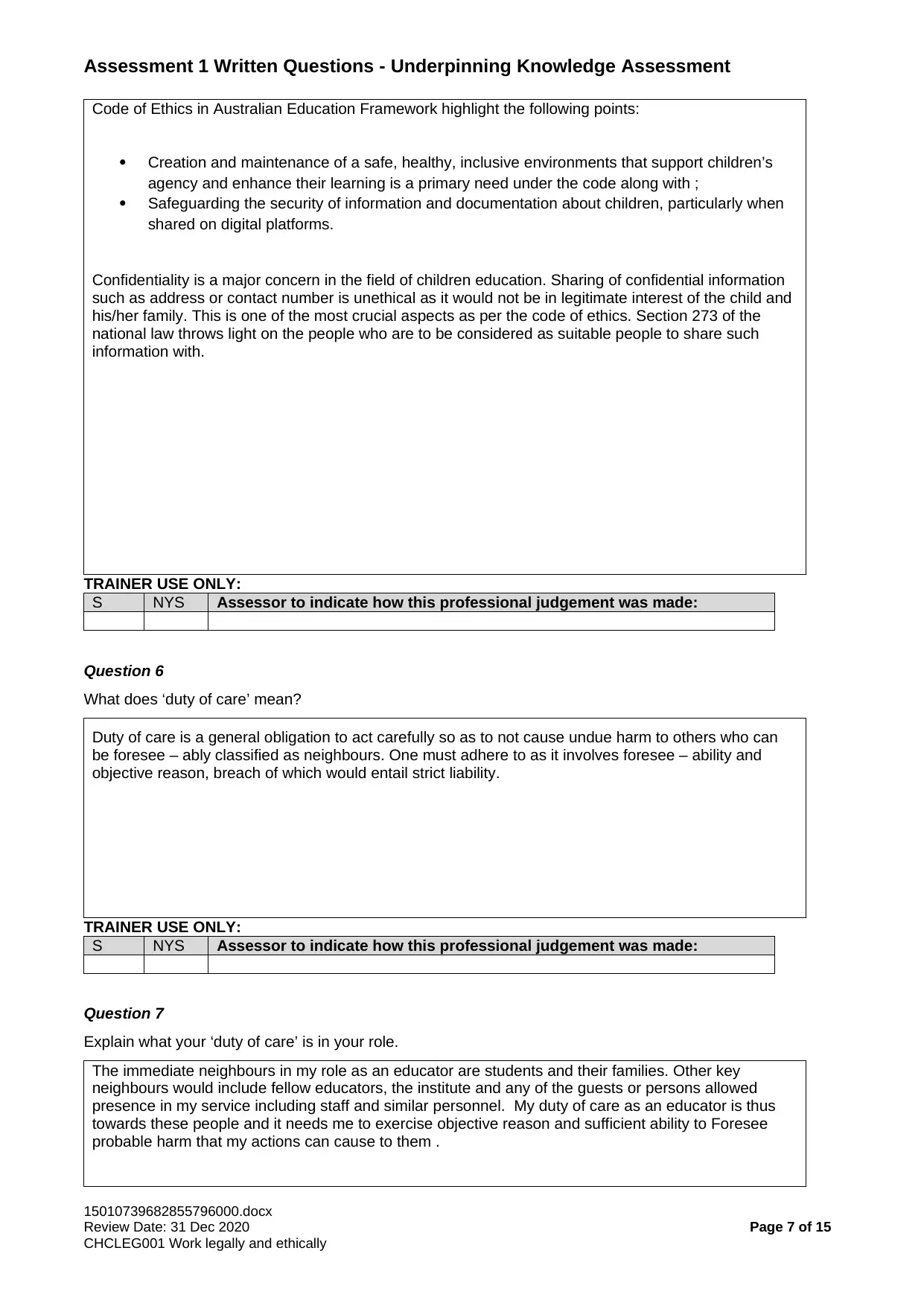
Assessment 1 Written Questions - Underpinning Knowledge Assessment
Code of Ethics in Australian Education Framework highlight the following points:
Creation and maintenance of a safe, healthy, inclusive environments that support children’s
agency and enhance their learning is a primary need under the code along with ;
Safeguarding the security of information and documentation about children, particularly when
shared on digital platforms.
Confidentiality is a major concern in the field of children education. Sharing of confidential information
such as address or contact number is unethical as it would not be in legitimate interest of the child and
his/her family. This is one of the most crucial aspects as per the code of ethics. Section 273 of the
national law throws light on the people who are to be considered as suitable people to share such
information with.
TRAINER USE ONLY:
S NYS Assessor to indicate how this professional judgement was made:
Question 6
What does ‘duty of care’ mean?
Duty of care is a general obligation to act carefully so as to not cause undue harm to others who can
be foresee – ably classified as neighbours. One must adhere to as it involves foresee – ability and
objective reason, breach of which would entail strict liability.
TRAINER USE ONLY:
S NYS Assessor to indicate how this professional judgement was made:
Question 7
Explain what your ‘duty of care’ is in your role.
The immediate neighbours in my role as an educator are students and their families. Other key
neighbours would include fellow educators, the institute and any of the guests or persons allowed
presence in my service including staff and similar personnel. My duty of care as an educator is thus
towards these people and it needs me to exercise objective reason and sufficient ability to Foresee
probable harm that my actions can cause to them .
15010739682855796000.docx
Review Date: 31 Dec 2020 Page 7 of 15
CHCLEG001 Work legally and ethically
Code of Ethics in Australian Education Framework highlight the following points:
Creation and maintenance of a safe, healthy, inclusive environments that support children’s
agency and enhance their learning is a primary need under the code along with ;
Safeguarding the security of information and documentation about children, particularly when
shared on digital platforms.
Confidentiality is a major concern in the field of children education. Sharing of confidential information
such as address or contact number is unethical as it would not be in legitimate interest of the child and
his/her family. This is one of the most crucial aspects as per the code of ethics. Section 273 of the
national law throws light on the people who are to be considered as suitable people to share such
information with.
TRAINER USE ONLY:
S NYS Assessor to indicate how this professional judgement was made:
Question 6
What does ‘duty of care’ mean?
Duty of care is a general obligation to act carefully so as to not cause undue harm to others who can
be foresee – ably classified as neighbours. One must adhere to as it involves foresee – ability and
objective reason, breach of which would entail strict liability.
TRAINER USE ONLY:
S NYS Assessor to indicate how this professional judgement was made:
Question 7
Explain what your ‘duty of care’ is in your role.
The immediate neighbours in my role as an educator are students and their families. Other key
neighbours would include fellow educators, the institute and any of the guests or persons allowed
presence in my service including staff and similar personnel. My duty of care as an educator is thus
towards these people and it needs me to exercise objective reason and sufficient ability to Foresee
probable harm that my actions can cause to them .
15010739682855796000.docx
Review Date: 31 Dec 2020 Page 7 of 15
CHCLEG001 Work legally and ethically
Paraphrase This Document
Need a fresh take? Get an instant paraphrase of this document with our AI Paraphraser
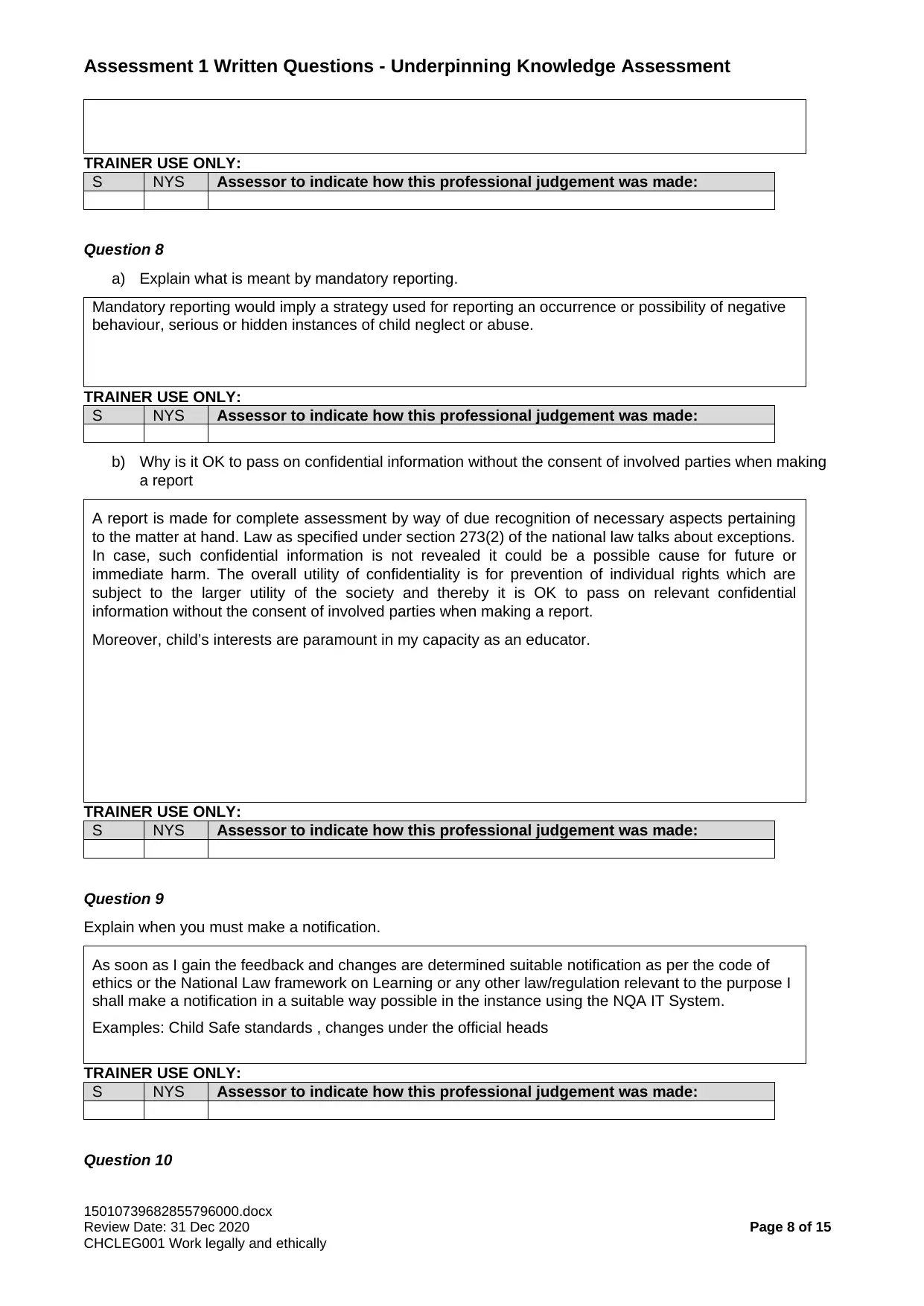
Assessment 1 Written Questions - Underpinning Knowledge Assessment
TRAINER USE ONLY:
S NYS Assessor to indicate how this professional judgement was made:
Question 8
a) Explain what is meant by mandatory reporting.
Mandatory reporting would imply a strategy used for reporting an occurrence or possibility of negative
behaviour, serious or hidden instances of child neglect or abuse.
TRAINER USE ONLY:
S NYS Assessor to indicate how this professional judgement was made:
b) Why is it OK to pass on confidential information without the consent of involved parties when making
a report
A report is made for complete assessment by way of due recognition of necessary aspects pertaining
to the matter at hand. Law as specified under section 273(2) of the national law talks about exceptions.
In case, such confidential information is not revealed it could be a possible cause for future or
immediate harm. The overall utility of confidentiality is for prevention of individual rights which are
subject to the larger utility of the society and thereby it is OK to pass on relevant confidential
information without the consent of involved parties when making a report.
Moreover, child’s interests are paramount in my capacity as an educator.
TRAINER USE ONLY:
S NYS Assessor to indicate how this professional judgement was made:
Question 9
Explain when you must make a notification.
As soon as I gain the feedback and changes are determined suitable notification as per the code of
ethics or the National Law framework on Learning or any other law/regulation relevant to the purpose I
shall make a notification in a suitable way possible in the instance using the NQA IT System.
Examples: Child Safe standards , changes under the official heads
TRAINER USE ONLY:
S NYS Assessor to indicate how this professional judgement was made:
Question 10
15010739682855796000.docx
Review Date: 31 Dec 2020 Page 8 of 15
CHCLEG001 Work legally and ethically
TRAINER USE ONLY:
S NYS Assessor to indicate how this professional judgement was made:
Question 8
a) Explain what is meant by mandatory reporting.
Mandatory reporting would imply a strategy used for reporting an occurrence or possibility of negative
behaviour, serious or hidden instances of child neglect or abuse.
TRAINER USE ONLY:
S NYS Assessor to indicate how this professional judgement was made:
b) Why is it OK to pass on confidential information without the consent of involved parties when making
a report
A report is made for complete assessment by way of due recognition of necessary aspects pertaining
to the matter at hand. Law as specified under section 273(2) of the national law talks about exceptions.
In case, such confidential information is not revealed it could be a possible cause for future or
immediate harm. The overall utility of confidentiality is for prevention of individual rights which are
subject to the larger utility of the society and thereby it is OK to pass on relevant confidential
information without the consent of involved parties when making a report.
Moreover, child’s interests are paramount in my capacity as an educator.
TRAINER USE ONLY:
S NYS Assessor to indicate how this professional judgement was made:
Question 9
Explain when you must make a notification.
As soon as I gain the feedback and changes are determined suitable notification as per the code of
ethics or the National Law framework on Learning or any other law/regulation relevant to the purpose I
shall make a notification in a suitable way possible in the instance using the NQA IT System.
Examples: Child Safe standards , changes under the official heads
TRAINER USE ONLY:
S NYS Assessor to indicate how this professional judgement was made:
Question 10
15010739682855796000.docx
Review Date: 31 Dec 2020 Page 8 of 15
CHCLEG001 Work legally and ethically
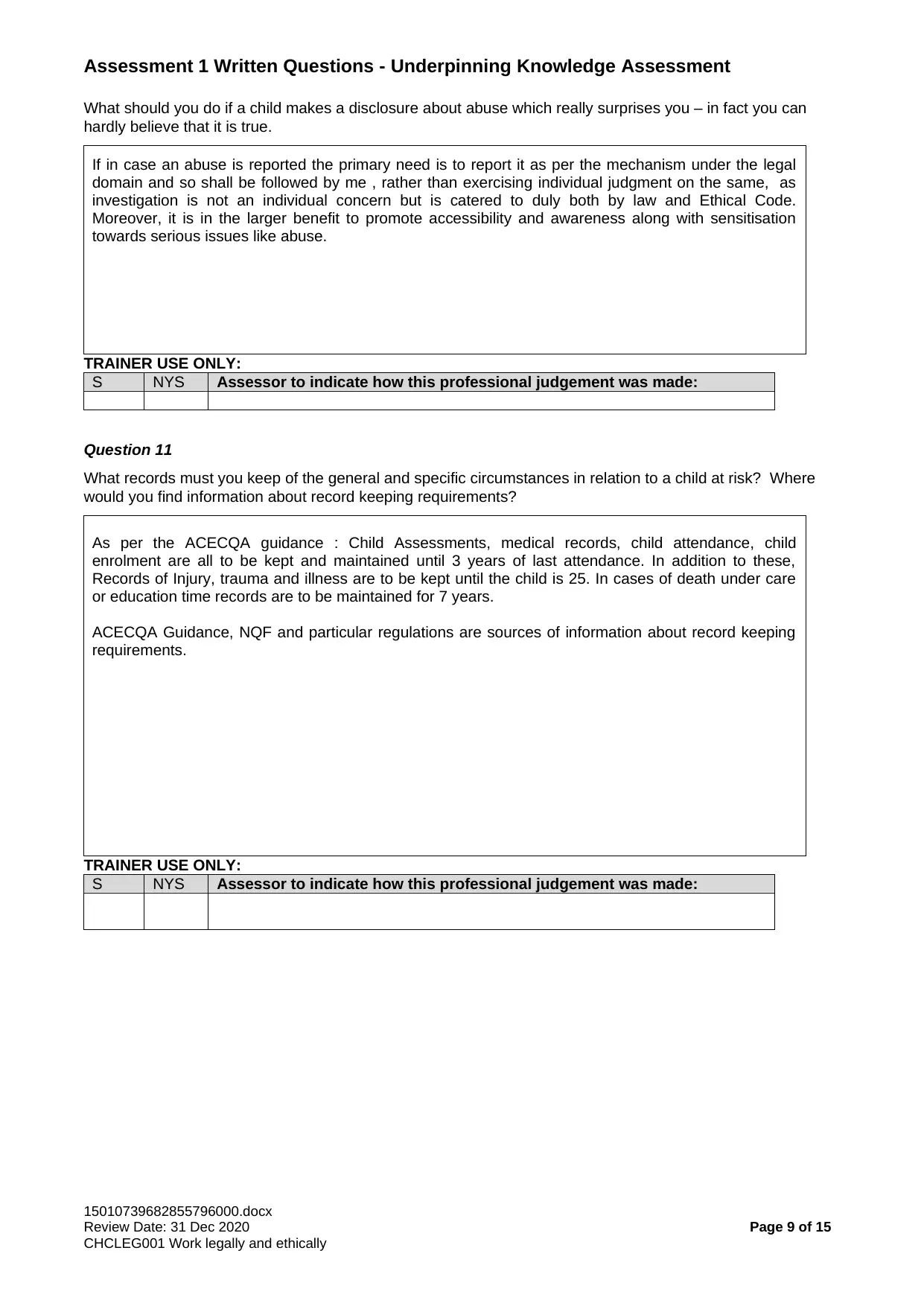
Assessment 1 Written Questions - Underpinning Knowledge Assessment
What should you do if a child makes a disclosure about abuse which really surprises you – in fact you can
hardly believe that it is true.
If in case an abuse is reported the primary need is to report it as per the mechanism under the legal
domain and so shall be followed by me , rather than exercising individual judgment on the same, as
investigation is not an individual concern but is catered to duly both by law and Ethical Code.
Moreover, it is in the larger benefit to promote accessibility and awareness along with sensitisation
towards serious issues like abuse.
TRAINER USE ONLY:
S NYS Assessor to indicate how this professional judgement was made:
Question 11
What records must you keep of the general and specific circumstances in relation to a child at risk? Where
would you find information about record keeping requirements?
As per the ACECQA guidance : Child Assessments, medical records, child attendance, child
enrolment are all to be kept and maintained until 3 years of last attendance. In addition to these,
Records of Injury, trauma and illness are to be kept until the child is 25. In cases of death under care
or education time records are to be maintained for 7 years.
ACECQA Guidance, NQF and particular regulations are sources of information about record keeping
requirements.
TRAINER USE ONLY:
S NYS Assessor to indicate how this professional judgement was made:
15010739682855796000.docx
Review Date: 31 Dec 2020 Page 9 of 15
CHCLEG001 Work legally and ethically
What should you do if a child makes a disclosure about abuse which really surprises you – in fact you can
hardly believe that it is true.
If in case an abuse is reported the primary need is to report it as per the mechanism under the legal
domain and so shall be followed by me , rather than exercising individual judgment on the same, as
investigation is not an individual concern but is catered to duly both by law and Ethical Code.
Moreover, it is in the larger benefit to promote accessibility and awareness along with sensitisation
towards serious issues like abuse.
TRAINER USE ONLY:
S NYS Assessor to indicate how this professional judgement was made:
Question 11
What records must you keep of the general and specific circumstances in relation to a child at risk? Where
would you find information about record keeping requirements?
As per the ACECQA guidance : Child Assessments, medical records, child attendance, child
enrolment are all to be kept and maintained until 3 years of last attendance. In addition to these,
Records of Injury, trauma and illness are to be kept until the child is 25. In cases of death under care
or education time records are to be maintained for 7 years.
ACECQA Guidance, NQF and particular regulations are sources of information about record keeping
requirements.
TRAINER USE ONLY:
S NYS Assessor to indicate how this professional judgement was made:
15010739682855796000.docx
Review Date: 31 Dec 2020 Page 9 of 15
CHCLEG001 Work legally and ethically
⊘ This is a preview!⊘
Do you want full access?
Subscribe today to unlock all pages.

Trusted by 1+ million students worldwide
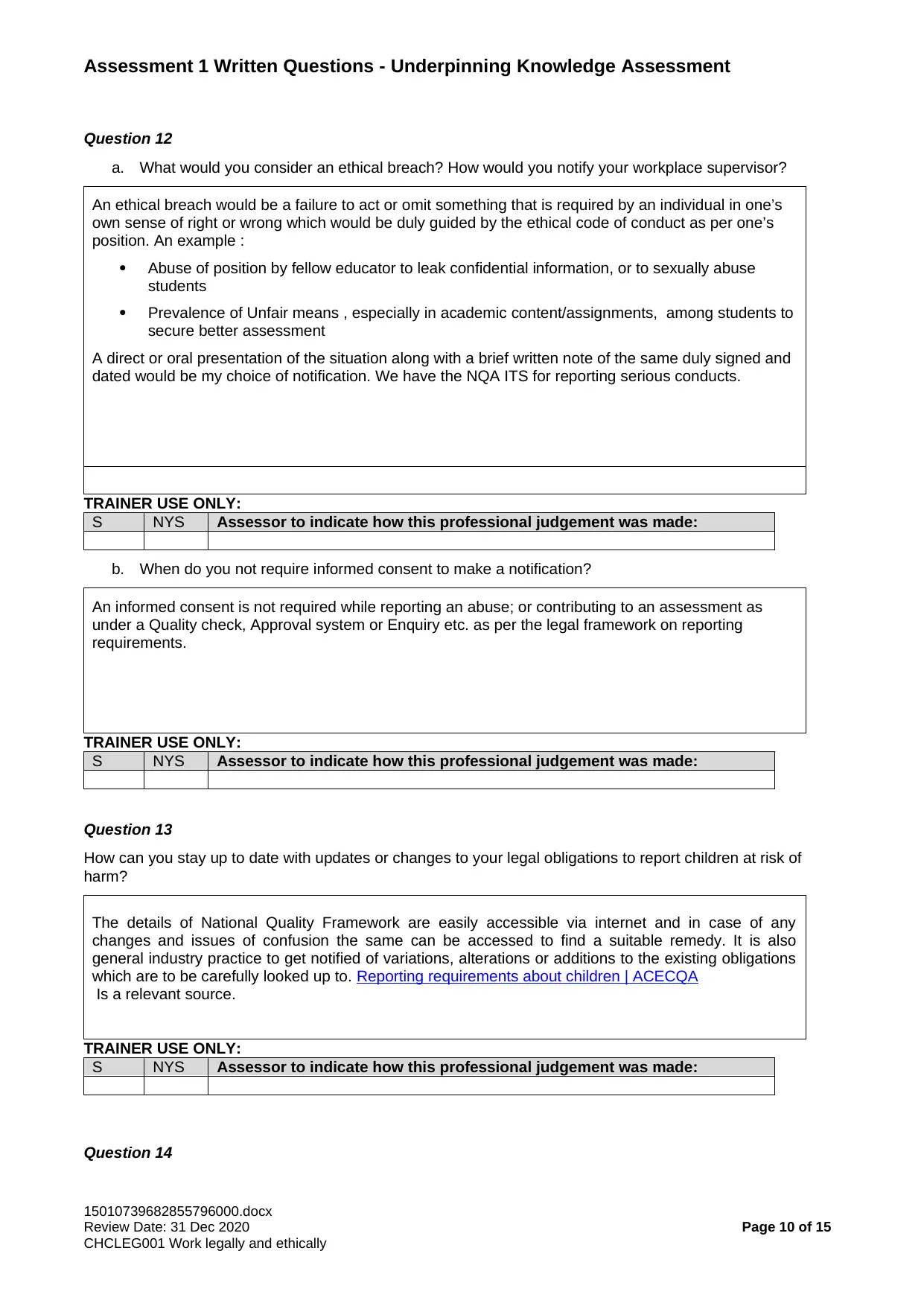
Assessment 1 Written Questions - Underpinning Knowledge Assessment
Question 12
a. What would you consider an ethical breach? How would you notify your workplace supervisor?
An ethical breach would be a failure to act or omit something that is required by an individual in one’s
own sense of right or wrong which would be duly guided by the ethical code of conduct as per one’s
position. An example :
Abuse of position by fellow educator to leak confidential information, or to sexually abuse
students
Prevalence of Unfair means , especially in academic content/assignments, among students to
secure better assessment
A direct or oral presentation of the situation along with a brief written note of the same duly signed and
dated would be my choice of notification. We have the NQA ITS for reporting serious conducts.
TRAINER USE ONLY:
S NYS Assessor to indicate how this professional judgement was made:
b. When do you not require informed consent to make a notification?
An informed consent is not required while reporting an abuse; or contributing to an assessment as
under a Quality check, Approval system or Enquiry etc. as per the legal framework on reporting
requirements.
TRAINER USE ONLY:
S NYS Assessor to indicate how this professional judgement was made:
Question 13
How can you stay up to date with updates or changes to your legal obligations to report children at risk of
harm?
The details of National Quality Framework are easily accessible via internet and in case of any
changes and issues of confusion the same can be accessed to find a suitable remedy. It is also
general industry practice to get notified of variations, alterations or additions to the existing obligations
which are to be carefully looked up to. Reporting requirements about children | ACECQA
Is a relevant source.
TRAINER USE ONLY:
S NYS Assessor to indicate how this professional judgement was made:
Question 14
15010739682855796000.docx
Review Date: 31 Dec 2020 Page 10 of 15
CHCLEG001 Work legally and ethically
Question 12
a. What would you consider an ethical breach? How would you notify your workplace supervisor?
An ethical breach would be a failure to act or omit something that is required by an individual in one’s
own sense of right or wrong which would be duly guided by the ethical code of conduct as per one’s
position. An example :
Abuse of position by fellow educator to leak confidential information, or to sexually abuse
students
Prevalence of Unfair means , especially in academic content/assignments, among students to
secure better assessment
A direct or oral presentation of the situation along with a brief written note of the same duly signed and
dated would be my choice of notification. We have the NQA ITS for reporting serious conducts.
TRAINER USE ONLY:
S NYS Assessor to indicate how this professional judgement was made:
b. When do you not require informed consent to make a notification?
An informed consent is not required while reporting an abuse; or contributing to an assessment as
under a Quality check, Approval system or Enquiry etc. as per the legal framework on reporting
requirements.
TRAINER USE ONLY:
S NYS Assessor to indicate how this professional judgement was made:
Question 13
How can you stay up to date with updates or changes to your legal obligations to report children at risk of
harm?
The details of National Quality Framework are easily accessible via internet and in case of any
changes and issues of confusion the same can be accessed to find a suitable remedy. It is also
general industry practice to get notified of variations, alterations or additions to the existing obligations
which are to be carefully looked up to. Reporting requirements about children | ACECQA
Is a relevant source.
TRAINER USE ONLY:
S NYS Assessor to indicate how this professional judgement was made:
Question 14
15010739682855796000.docx
Review Date: 31 Dec 2020 Page 10 of 15
CHCLEG001 Work legally and ethically
Paraphrase This Document
Need a fresh take? Get an instant paraphrase of this document with our AI Paraphraser
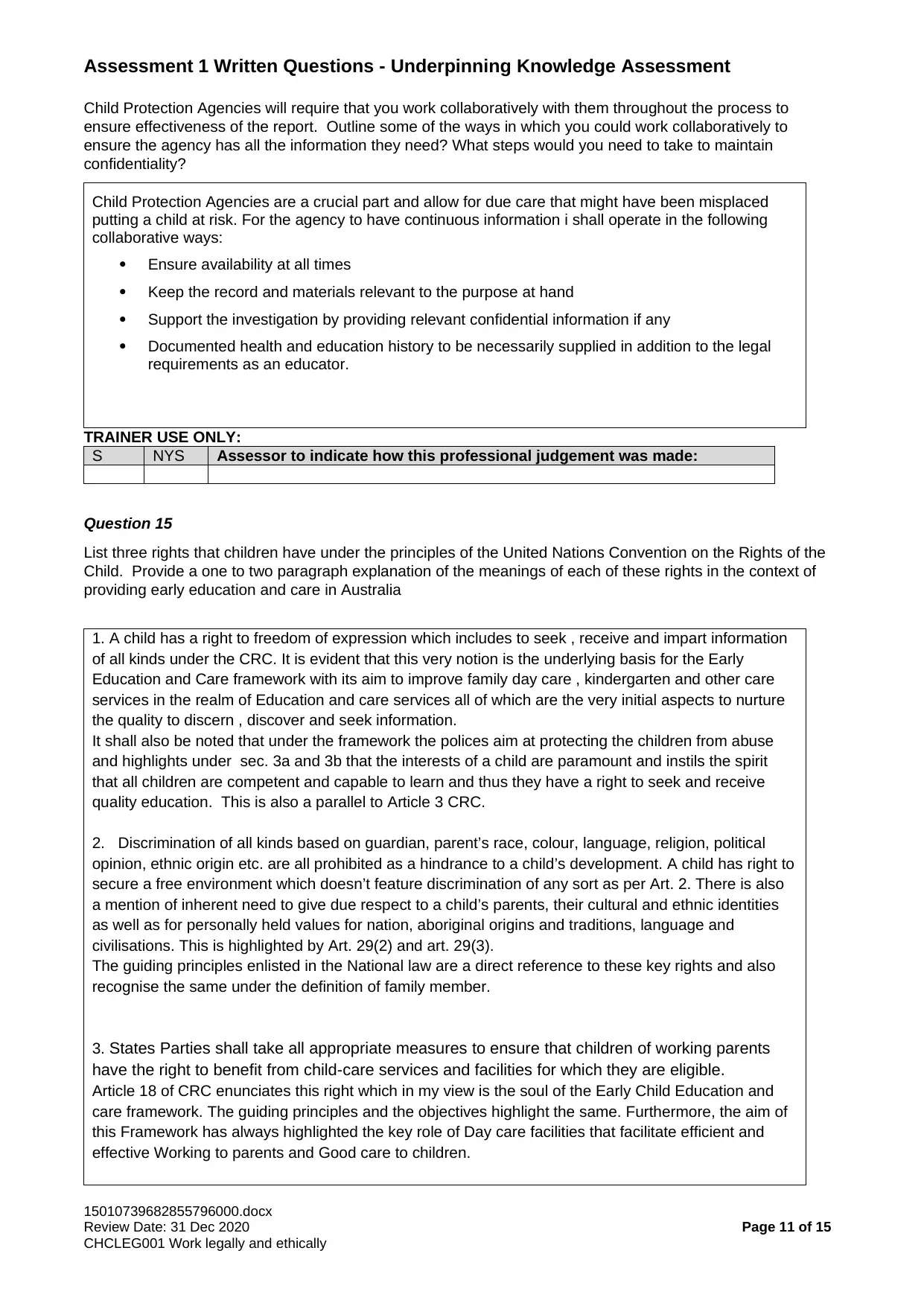
Assessment 1 Written Questions - Underpinning Knowledge Assessment
Child Protection Agencies will require that you work collaboratively with them throughout the process to
ensure effectiveness of the report. Outline some of the ways in which you could work collaboratively to
ensure the agency has all the information they need? What steps would you need to take to maintain
confidentiality?
Child Protection Agencies are a crucial part and allow for due care that might have been misplaced
putting a child at risk. For the agency to have continuous information i shall operate in the following
collaborative ways:
Ensure availability at all times
Keep the record and materials relevant to the purpose at hand
Support the investigation by providing relevant confidential information if any
Documented health and education history to be necessarily supplied in addition to the legal
requirements as an educator.
TRAINER USE ONLY:
S NYS Assessor to indicate how this professional judgement was made:
Question 15
List three rights that children have under the principles of the United Nations Convention on the Rights of the
Child. Provide a one to two paragraph explanation of the meanings of each of these rights in the context of
providing early education and care in Australia
1. A child has a right to freedom of expression which includes to seek , receive and impart information
of all kinds under the CRC. It is evident that this very notion is the underlying basis for the Early
Education and Care framework with its aim to improve family day care , kindergarten and other care
services in the realm of Education and care services all of which are the very initial aspects to nurture
the quality to discern , discover and seek information.
It shall also be noted that under the framework the polices aim at protecting the children from abuse
and highlights under sec. 3a and 3b that the interests of a child are paramount and instils the spirit
that all children are competent and capable to learn and thus they have a right to seek and receive
quality education. This is also a parallel to Article 3 CRC.
2. Discrimination of all kinds based on guardian, parent’s race, colour, language, religion, political
opinion, ethnic origin etc. are all prohibited as a hindrance to a child’s development. A child has right to
secure a free environment which doesn’t feature discrimination of any sort as per Art. 2. There is also
a mention of inherent need to give due respect to a child’s parents, their cultural and ethnic identities
as well as for personally held values for nation, aboriginal origins and traditions, language and
civilisations. This is highlighted by Art. 29(2) and art. 29(3).
The guiding principles enlisted in the National law are a direct reference to these key rights and also
recognise the same under the definition of family member.
3. States Parties shall take all appropriate measures to ensure that children of working parents
have the right to benefit from child-care services and facilities for which they are eligible.
Article 18 of CRC enunciates this right which in my view is the soul of the Early Child Education and
care framework. The guiding principles and the objectives highlight the same. Furthermore, the aim of
this Framework has always highlighted the key role of Day care facilities that facilitate efficient and
effective Working to parents and Good care to children.
15010739682855796000.docx
Review Date: 31 Dec 2020 Page 11 of 15
CHCLEG001 Work legally and ethically
Child Protection Agencies will require that you work collaboratively with them throughout the process to
ensure effectiveness of the report. Outline some of the ways in which you could work collaboratively to
ensure the agency has all the information they need? What steps would you need to take to maintain
confidentiality?
Child Protection Agencies are a crucial part and allow for due care that might have been misplaced
putting a child at risk. For the agency to have continuous information i shall operate in the following
collaborative ways:
Ensure availability at all times
Keep the record and materials relevant to the purpose at hand
Support the investigation by providing relevant confidential information if any
Documented health and education history to be necessarily supplied in addition to the legal
requirements as an educator.
TRAINER USE ONLY:
S NYS Assessor to indicate how this professional judgement was made:
Question 15
List three rights that children have under the principles of the United Nations Convention on the Rights of the
Child. Provide a one to two paragraph explanation of the meanings of each of these rights in the context of
providing early education and care in Australia
1. A child has a right to freedom of expression which includes to seek , receive and impart information
of all kinds under the CRC. It is evident that this very notion is the underlying basis for the Early
Education and Care framework with its aim to improve family day care , kindergarten and other care
services in the realm of Education and care services all of which are the very initial aspects to nurture
the quality to discern , discover and seek information.
It shall also be noted that under the framework the polices aim at protecting the children from abuse
and highlights under sec. 3a and 3b that the interests of a child are paramount and instils the spirit
that all children are competent and capable to learn and thus they have a right to seek and receive
quality education. This is also a parallel to Article 3 CRC.
2. Discrimination of all kinds based on guardian, parent’s race, colour, language, religion, political
opinion, ethnic origin etc. are all prohibited as a hindrance to a child’s development. A child has right to
secure a free environment which doesn’t feature discrimination of any sort as per Art. 2. There is also
a mention of inherent need to give due respect to a child’s parents, their cultural and ethnic identities
as well as for personally held values for nation, aboriginal origins and traditions, language and
civilisations. This is highlighted by Art. 29(2) and art. 29(3).
The guiding principles enlisted in the National law are a direct reference to these key rights and also
recognise the same under the definition of family member.
3. States Parties shall take all appropriate measures to ensure that children of working parents
have the right to benefit from child-care services and facilities for which they are eligible.
Article 18 of CRC enunciates this right which in my view is the soul of the Early Child Education and
care framework. The guiding principles and the objectives highlight the same. Furthermore, the aim of
this Framework has always highlighted the key role of Day care facilities that facilitate efficient and
effective Working to parents and Good care to children.
15010739682855796000.docx
Review Date: 31 Dec 2020 Page 11 of 15
CHCLEG001 Work legally and ethically
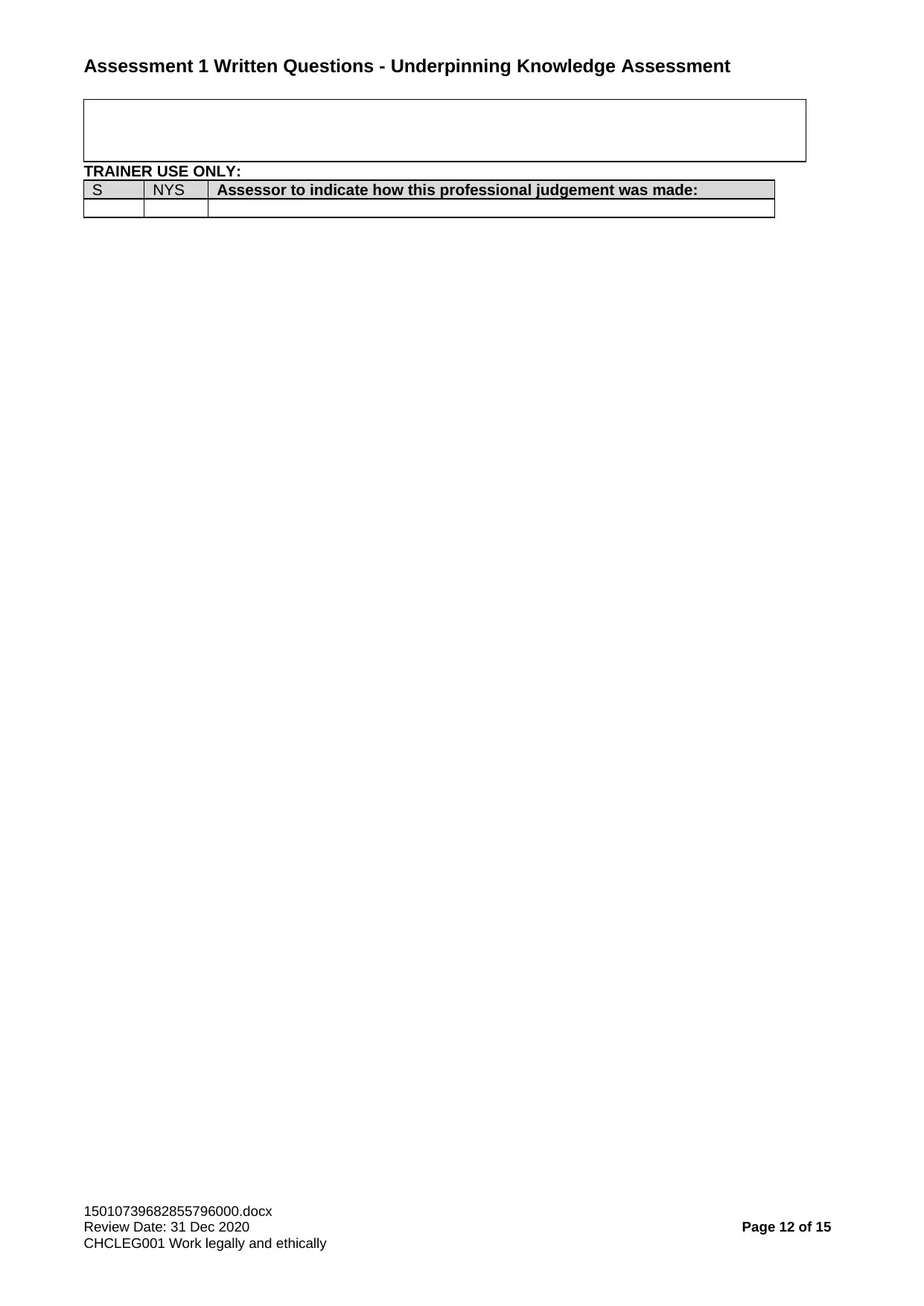
Assessment 1 Written Questions - Underpinning Knowledge Assessment
TRAINER USE ONLY:
S NYS Assessor to indicate how this professional judgement was made:
15010739682855796000.docx
Review Date: 31 Dec 2020 Page 12 of 15
CHCLEG001 Work legally and ethically
TRAINER USE ONLY:
S NYS Assessor to indicate how this professional judgement was made:
15010739682855796000.docx
Review Date: 31 Dec 2020 Page 12 of 15
CHCLEG001 Work legally and ethically
⊘ This is a preview!⊘
Do you want full access?
Subscribe today to unlock all pages.

Trusted by 1+ million students worldwide
1 out of 15
Related Documents
Your All-in-One AI-Powered Toolkit for Academic Success.
+13062052269
info@desklib.com
Available 24*7 on WhatsApp / Email
![[object Object]](/_next/static/media/star-bottom.7253800d.svg)
Unlock your academic potential
Copyright © 2020–2025 A2Z Services. All Rights Reserved. Developed and managed by ZUCOL.





